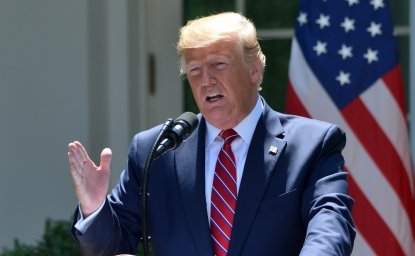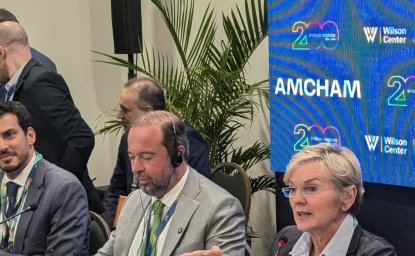
A blog of the Brazil Institute
Samarco’s Renova Foundation will spend $12 billion reais (approximately $3.1 billion dollars) on repairs for the Fundão dam over the next ten years, 40 percent of which will go towards compensatory measures. In 2018, the president of the foundation, Roberto Waack, affirmed that “repairs have to happen, regardless of their value.”
Three years ago, in November 2015, the Fundão dam collapsed in Minas Gerais, unleashing 60 million cubic meters of iron ore waste and mud—the equivalent of 21,000 Olympic-sized swimming pools. The onslaught flattened neighboring towns, such as Bento Rodrigues, and poured into the Doce River (Rio Doce in Portuguese), killing 19 people and destroying 600 family homes. At the time, then-President Dilma Rousseff referred to the incident as “the worst environmental disaster Brazil has ever seen.” Over the next several weeks, the contaminated mud flowed downstream, causing further environmental damage. In addition, the crisis affected local communities’ economic security, physical and mental health, and their relationships with their environment.
In 2016, 21 individuals from Samarco, the company that owned the Fundão dam, and its associates, Vale and BHP, were charged with homicide; and all three companies were charged with 12 counts of environmental crime. The responsible parties have also paid hefty fines for failing to fund necessary repairs and to compensate those affected by the dam’s collapse. Although memories of this tragedy have begun to fade, it will take years to understand the full impact of the environmental disaster, and years for the region to heal.
Lingering Threat to Biodiversity
Even before the rupture of the Fundão dam, the Doce River faced numerous environmental issues, such as pollution, deforestation, and erosion. However, many scientists have argued that the pollution the dam released was the final nail in the river’s coffin. Scientists estimate that the river will take 10 to 20 years to recover from this disaster—if it recovers at all.
The initial injection of metal-contaminated mud into the Doce River resulted in mass die-offs among fish, either due to asphyxiation, as the mud absorbed the oxygen in the river, or osmosis, as the fish near the mouth of the river tried to escape the toxic mud by entering the ocean. Once the mud reached the open ocean, a total of 29,000 fish carcasses were collected and recorded by the Federal Police. In total, 98 different species of fish were affected, 13 of which were exclusive to the Doce River. Of those species, 11 were already at risk of extinction. The pollution did not only harm the aquatic fauna: The contamination of and mass die-off of fish resulted in hundreds of birds dying from starvation. In addition to the loss of native fauna, 80 percent of the native vegetation located near the tributaries and main channel of the Doce River was destroyed, leaving the river with only 13 percent of the Atlantic forest’s original vegetation. This negative impact on the biodiversity of the Doce River basin will become more evident as scientists track the extent of the region’s recovery.
Furthermore, the damage was not limited to the Doce River basin. Satellite images and various studies confirmed that the mineral waste spread into the ocean, reaching as far north as the national marine park of Abrolhos in Bahia and as far south as the state of Rio de Janeiro. This stretch of affected area is one of the most biologically diverse regions in the South Atlantic Ocean. The spread of the metal-waste pollution to the coastal regions can be seen clearly from satellite images, as the increase of iron in the water caused huge algal blooms in the affected areas and a 200 percent increase of zooplankton in the most heavily impacted areas. The mud and algal blooms block sunlight from reaching undersea marine life, preventing photosynthesis in marine vegetation and endangering the life cycle of coral. This presents risks to the biodiversity of the region, as well as the local economy, which depends primarily on tourism.
The Toll on Surrounding Communities
The human consequences of the dam collapse have also been far-reaching. A report published by Brazil’s Institute of Applied Economic Research (IPEA) found that the disaster harmed the economies of an estimated 226 municipalities, impacting roughly 320,000 people, which has contributed to increases in physical and mental health issues in local communities.
The pollution of the Doce River led municipalities in the states of Minas Gerais and Espírito Santo to prohibit fishing in the Doce River, its tributaries, and the oceanic water near the mouth of the river indefinitely, both for the safety and health of the people in the area and to allow the diminished fish populations to recover. Studies conducted by the Chico Mendes Institute for Biodiversity Conservation (ICMBIO) show that metal contamination of fish in the Doce River is, on average, 140 times above the legal limit for consumption. Yet these restrictions and the pollution have left fishing communities along the Doce River, its tributaries, and the coast of Espírito Santo without traditional sources of income. In the small town of Regência, for example, the pollution from the Fundão dam cost fishermen their livelihoods even as dwindling tourism forced local hostels, restaurants, and eco-tourism companies out of business.
The leftover metal waste also seems to have affected the physical health of residents who live near the dam, most notably those in the municipality of Barra Longa. There remains a high level of contaminated dust the region, which residents inhale and absorb through their skin. A number of independent studies believe this could be linked to health issues reported by the residents as early as two months after the initial rupture of the dam. One study found that approximately 77.9 percent of both rural and urban residents of Barra Longa reported having worsening health issues since the disaster, with symptoms such as headaches, coughing, leg pains, and allergic reactions. In addition to increased physical health problems, studies show that 83.4 percent of citizens reported some type of mental health or emotional issue that developed after the Fundão dam incident, with the most commonly reported symptoms being insomnia, anxiety, being easily startled, and mood swings.
However, the scope of these studies has been limited and direct cause is difficult to establish. Barra Longa is a traditional mining town, meaning that residents could have been exposed to high levels of metal even before the dam broke, and there were no baseline tests conducted prior to the disaster. Following the rupture of the dam, the Samarco mining company created the Renova Foundation, an independent entity, to deal with immediate post-disaster management and the long-term aftermath and cleanup in Mariana, including assisting local residents. Renova published a statement earlier this year claiming that they found no proof, from independent publications or their own research and monitoring, of an unequivocal connection between health concerns in Barra Longa and the mineral pollution caused by the dam failure.
Samarco Takes Action in Post-Disaster Management
Renova’s efforts to handle the aftermath of the Mariana environmental disaster continue to this day. The foundation has focused on three core themes: People and Communities, Land and Water, and Reconstruction and Infrastructure, administering over 40 projects in the region from academic studies assessing the environmental and socioeconomic impacts of the disaster, to providing additional health care professionals and assisting with water treatment. However, many local residents still feel that they have not been adequately compensated for their losses.
One of Renova’s primary functions has been to administer indemnities to those impacted by the disaster. The Renova Foundation estimates that over 11,000 families, or approximately 25,000 people, have received some form of emergency financial aid in the last three years. Renova has also granted indemnities for destruction of property and issues related to water quality, paying a total of $1.2 billion reais (approximately $320 million dollars) in indemnities over the last three years. Furthermore, those who can prove their unemployment is a direct result of the dam failure, such as many fishermen, can often claim monthly paychecks, and some are even employed directly by Renova to help with monitoring and data collection. Nevertheless, many people who suffered economic losses in a more indirect manner, such as those who depended upon tourism, have been forced to close down their businesses or relocate. Renova has also helped pay the medical bill of hundreds whose health worsened due to the pollution, but others are left without any compensation. In more severe cases, doctors have recommended that individuals leave the towns in which their families have lived for generations due to the health hazards caused by the pollution.
In truth, how can any company make up for the loss of identity, historic relics, family homes, and memories; or fix the mental and physical issues that may have long-term impacts on quality of life? Unfortunately, much of what has been lost will take decades to recover and rebuild, regardless of the efforts of the Renova Foundation. There is no precedent for how to deal with these consequences and, due to the extensive research required, we will likely not understand the full scope of this disaster for years to come.
An Ounce of Prevention
Nonetheless, there is already enough information and data to learn from mistakes that contributed to the Fundão dam disaster. It seems likely that the incoming president, Jair Bolsonaro, will favor more flexible environmental regulations in an effort to encourage industry and economic growth, and reward key elements of his political base. Yet as the Mariana disaster demonstrates, environmental disasters can snowball into much more complicated problems and often affect a much larger area than the one initially impacted. Sensible environmental and safety regulations—along with routine enforcement—could help prevent the destruction of uniquely fragile ecosystems and avoid negative health and socioeconomic impacts on local communities, while reducing the likelihood that another company will face the legal and political nightmare faced by Samarco and its partners Vale and BHP.
The recent release of the UN report on climate change makes it clear that we have a limited amount of time to address many of the environmental issues facing this planet, and Brazil has the potential to play an important role. As a nation that is home to the majority of the Amazon Rainforest, incredible biodiversity, and a wealth of natural resources, from minerals to arable land, Brazil is uniquely poised to act as a leader in the push for sustainable development. The disaster at Mariana shows how a multitude of people from diverse sectors—health care specialists, scientists, industry, environmentalists, educators, and politicians, among others—can come together in a time of need to address complicated environmental and socioeconomic issues.
Yet the disaster also acts as a costly reminder to companies around the world about the importance of preventative measures. There are many other lessons that can be gleamed from the last three years, but key among them is the need for private sector stakeholders to engage with government on sensible environmental and safety regulations from the onset, in order to protect the interests of both corporations and local populations by preventing future disasters before they occur.
Image by José Cruz/Agência Brasil
Author

Brazil Institute
The Brazil Institute—the only country-specific policy institution focused on Brazil in Washington—aims to deepen understanding of Brazil’s complex landscape and strengthen relations between Brazilian and US institutions across all sectors. Read more

Explore More in Brazil Builds
Browse Brazil Builds
They're Still Here: Brazil's unfinished reckoning with military impunity



